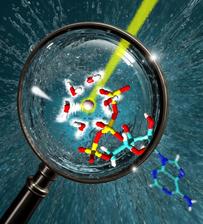In focus: Magnesium's Interaction with ATP in Water (Credit: Lukáš Tomaník, Univ. of Chemistry and Technology Prague)
A recent study published in the Journal of the American Chemical Society presents an in-depth analysis of how ATP (adenosine triphosphate) in aqueous solutions interacts with magnesium ions. Conducted by researchers from the Department of Molecular Physics at the Fritz-Haber-Institut (FHI) der Max-Planck-Gesellschaft (MPG) in Berlin (Germany), in collaboration with the University of Chemistry and Technology Prague (Czech Republic), the University of California, Berkeley, and the University of Southern California (both U.S.) , the paper titled "How Does Mg2+(aq) Interact with ATP(aq)? Biomolecular Structure through the Lens of Liquid-Jet Photoemission Spectroscopy" introduces Liquid-Jet Photoemission Spectroscopy (LJ-PES) as a method for probing the electronic structure of this biomolecule in a complex aqueous-solution environment. This research was initially carried also out at BESSY II and subsequently at the PETRA III beamline P04 at DESY.
ATP plays a key role in bioenergetics, enabling energy transfer within cells. The interaction between ATP and magnesium ions is critical for ATP's stability and function. This study aims to provide a clearer understanding of these interactions by employing LJ-PES, allowing for direct observation of the electronic structure of ATP in its aqueous environment and to even identify the occurring complexes with magnesium ions.
The research also highlights the application of LJ-PES in obtaining detailed site-specific information on the interaction between ATP and magnesium ions. By analyzing the photoelectron spectra, the study quantitatively reveals the interaction of magnesium ions with the different phosphate groups, and in addition it suggests an interaction with the adenine.
One of the study's key contributions is the demonstration of Intermolecular Coulombic Decay (ICD) spectroscopy as a valuable technique for examining the solvation shell of the magnesium ion in its different local environments.
The findings provide a detailed view of the electronic structure of ATP and its magnesium complexes, contributing to advancing our knowledge of the molecular mechanisms underlying phosphorylation and dephosphorylation reactions. These reactions are central to the energy-transfer processes that fuel biological activities.
These insights open up promising applications in the development of new drugs, the refinement of bioenergetics models, synthetic biology, diagnostic tools, and research into mineral metabolism disorders, highlighting their significance across a broad spectrum of scientific and medical disciplines.
(from FHI News (14 June))
Reference:
Karen Mudryk,Chin Lee, Lukáš Tomaník,Sebastian Malerz, Florian Trinter, Uwe Hergenhahn, Daniel M. Neumark, Petr Slavíček, Stephen Bradforth, Bernd Winter, "How Does Mg2+(aq) Interact with ATP(aq)? Biomolecular Structure
through the Lens of Liquid-Jet Photoemission Spectroscopy", J. Am. Chem. Soc. (2024), DOI: 10.1021/jacs.4c03174







